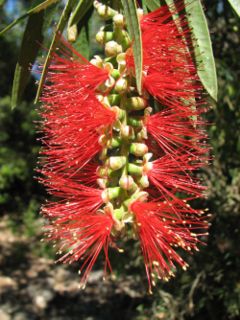
Callistemon is a genus of shrubs in the family Myrtaceae, first described as a genus in 1814. The entire genus is endemic to Australia but widely cultivated in many other regions and naturalised in scattered locations. Their status as a separate taxon is in doubt, some authorities accepting that the difference between callistemons and melaleucas is not sufficient for them to be grouped in a separate genus.

Melaleuca nesophila, commonly known as showy honey-myrtle, mindiyed or pink melaleuca, is a plant in the myrtle family, Myrtaceae and is endemic to an area near Albany in Western Australia. The Noongar name for the plant is mindiyet. Hardy and adaptable, with a dense crown of leaves and prolific heads of pink or purple flowers in late spring and summer, it is one of the most commonly cultivated melaleuca shrubs.

Melaleuca nematophylla, commonly known as wiry honey-myrtle is a plant in the myrtle family, Myrtaceae and is endemic to the south-west of Western Australia. It is one of the showiest melaleucas when in flower in early spring, is easily grown and has unusual needle-like foliage. As a result, it is relatively common in cultivation in temperate parts of Australia.
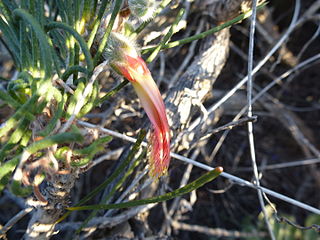
Calothamnus chrysanthereus , commonly known as claw flower is a plant in the myrtle family, Myrtaceae and is endemic to the south-west of Western Australia. It is an erect shrub with needle-shaped leaves crowded on the ends of the branches and bright red flowers in spring.
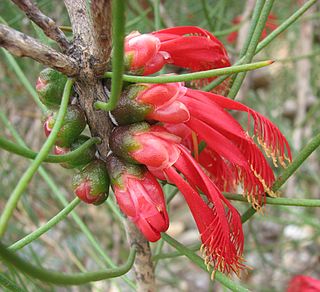
Calothamnus gilesii is a plant in the myrtle family, Myrtaceae and is endemic to the south-west of Western Australia. It is an erect, usually compact shrub with fine, pine-like foliage and which produces cluster of red flowers from June to January.
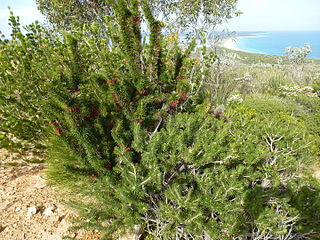
Calothamnus pinifolius, commonly known as dense clawflower, is a plant in the myrtle family, Myrtaceae and is endemic to the south-west of Western Australia. It is an erect shrub with dense foliage and clusters of red flowers, partly immersed in the prickly foliage, between July and January.

Melaleuca acuminata, commonly known as mallee honeymyrtle is a plant in the myrtle family, Myrtaceae and is native to Australia and widespread in temperate areas of the continent. It is an erect shrub to about 3 m (9.8 ft) usually found in mallee woodland.

Melaleuca calothamnoides is a plant in the myrtle family, Myrtaceae and is endemic to a relatively small area on the west coast of Western Australia. It has attractive red and green flowering spikes and soft foliage but has proven to be difficult to grow in gardens.

Melaleuca concreta is a plant in the myrtle family Myrtaceae and is endemic to the south-west of Western Australia. The species name (concreta) refers to the way the fruits are tightly packed together.

Melaleuca eleuterostachya is a plant in the myrtle family, Myrtaceae and is endemic to Western Australia and South Australia. It is a shrub or tree with arching branches, narrow leaves and small spikes of cream or white flowers.

Melaleuca filifolia, commonly called wiry honey-myrtle, is a plant in the myrtle family Myrtaceae, and is endemic to the south-west of Western Australia. It is a woody, twiggy shrub with needle-shaped leaves, greenish flower buds, pink "pom-pom" flower heads and spherical clusters of fruits.

Melaleuca glaberrima is a plant in the myrtle family, Myrtaceae and is endemic to the south-west of Western Australia. It is a dense, spreading shrub with needle shaped, but not sharp leaves and profuse pink or mauve flowers.
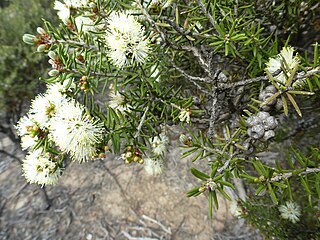
Melaleuca pauperiflora, commonly known as boree, is a plant in the myrtle family, Myrtaceae, and is native to the southern parts of South Australia and Western Australia. It is distinguished by its short, thick leaves and small but profuse heads of white or cream flowers. There are three subspecies.
Calothamnus blepharospermus is a plant in the myrtle family, Myrtaceae and is endemic to the west coast of Western Australia. It is an upright, spreading, bushy shrub with red flowers in summer. It grows in sandy soil in scrubby country called kwongan.

Calothamnus gibbosus, commonly known as corky net-bush, is a plant in the myrtle family, Myrtaceae and is endemic to the south-west of Western Australia. Its distinguishing characteristic is its corky bark in which the hypanthium of the flowers and much of the fruits is buried. Only the petals and stamens emerge from the bark.
Calothamnus microcarpus is a plant in the myrtle family, Myrtaceae and is endemic to the south-west of Western Australia. It is an erect, either compact or spreading shrub with flat leaves and clusters of red flowers in spring.
Calothamnus oldfieldii is a plant in the myrtle family, Myrtaceae and is endemic to the south-west of Western Australia. It is a small, spreading shrub with needle-shaped leaves and clusters of red flowers with 5 petals and 5 stamen bundles.

Calothamnus pachystachyus is a plant in the myrtle family, Myrtaceae and is endemic to the south-west of Western Australia. It is an erect, much-branched shrub with thick bark, flat leaves and clusters of red flowers in spring.

Phymatocarpus maxwellii is a plant in the myrtle family, Myrtaceae and is endemic to the south-west of Western Australia. It resembles many small species of Melaleuca, mainly differing in the way its anthers are attached at the top of the stamens. In Phymatocarpus they are attached at their base and open at the other end through two slits. It is a shrub with many small heads of pink to purple flowers, often covering the plant for several weeks in October.
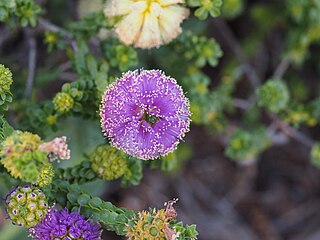
Phymatocarpus porphyrocephalus is a plant in the myrtle family, Myrtaceae and is endemic to the south-west of Western Australia. It resembles many small species of Melaleuca, mainly differing in the way its anthers are attached at the top of the stamens. In Phymatocarpus they are attached at their base and open at the other end through two slits. It is a shrub with many small heads of pink to purple flowers fading to white, often covering the plant for several weeks in spring.



















